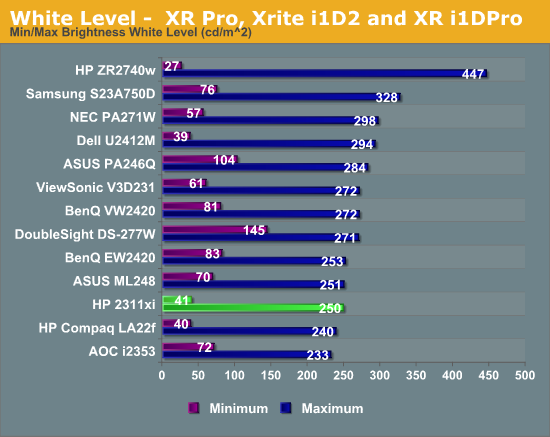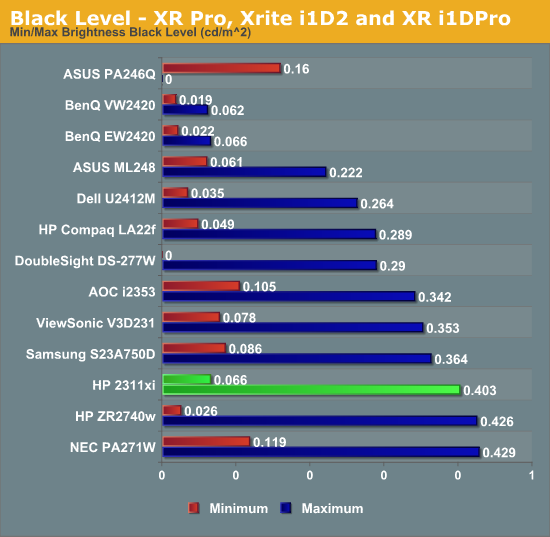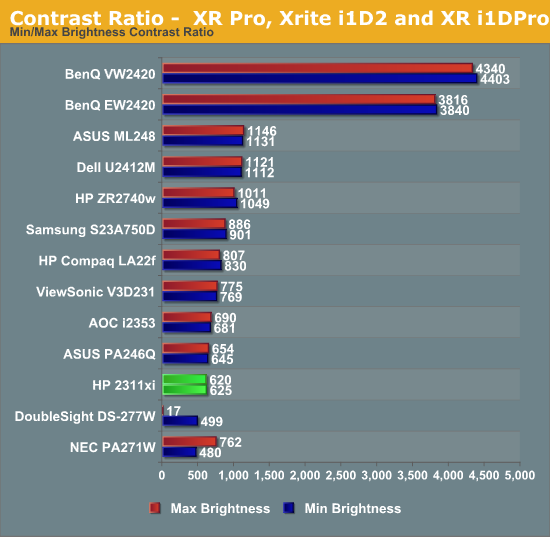HP 2311xi IPS Monitor
by Chris Heinonen on August 13, 2012 12:15 AM ESTHP 2311xi - Brightness and Contrast Ratios
HP rates the 2311xi for 250 nits maximum brightness and that’s exactly what I found it produced. If I turned the brightness all the way down it then put out only 41 nits, which gives you a lot of flexibility around adjusting the backlight level. 250 nits should be enough light output for most people, but if you have direct sunlight on your display for most of the day you might need something even more powerful to avoid it looking washed out.

For measuring the black levels, I made sure to leave the Dynamic Control off for the LEDs. With that enabled, it could potentially turn off the backlight completely, which would result in a black level of 0.000, but one that has no practical implications aside from a totally black screen. By leaving that disabled, we get a real-world measure of the black level. At maximum brightness, our black level is right around 0.4 nits, which is a little higher than other displays we have measured with similar peak white levels. The minimum level was 0.066, which correlates well with the white level change. Black levels are typically a little worse with IPS than with VA panels, which is the trade off for getting the other advantages an IPS display offers for color and viewing angles.

Looking at the contrast ratio, we are almost exact the same at minimum and maximum backlight, right around 620. I went ahead and measured this at 0-100% in increments of 10, and every measurement was between 620 and 625, so it’s a very consistent contrast ratio all across the range. It’s a perfectly normal and average contrast ratio, about what I’d expect from a budget IPS display.

Looking at the Brightness and Contrast numbers, the HP 2311xi is a decent but not exceptional performer. Nothing stands out, but everything about the performance so far is perfectly acceptable with the price involved.










68 Comments
View All Comments
mikato - Thursday, August 16, 2012 - link
Different resolutions in LCDs other than the native resolution look so crappy I don't know why you would want to change it. I'm not sure what you're doing in your video work but can't you scale it in the video player instead?For inputs, I think it's important to have one of [DVI, HDMI] and also one DisplayPort. That's because DVI and HDMI are electrically equivalent. converters are cheap and easy to come by. That's why the Dell U2412M has 1 DP, 1 DVI (and 1 VGA). If you want multiple monitors, then DisplayPort is the best way to go. If I was buying new stuff now I'd make sure the monitor had DP.
Just curious, do you remember what Dell monitors you had?
Sub Zero - Friday, August 17, 2012 - link
When you want to upload HD to YouTube, you have 1280x720 and 1920x1080. 1280x720 is generally preferred because of bandwidth and playback issues.So, if I want to present in 1280x720, I want to record in 1280x720 for the best quality. So, I set the screen to run 1280x720, and I want it to actually use 1280x720 pixels centered in the screen, as it should be. It works for me on 2 monitors, but not on my 30", even though I'm using the same Win 7 64 bit Nvidia drivers.
You may not see the need to use other than native resolution, but for people that do record often, either video games or tutorial, such variable resolution scenarios are common.
There is an entire industry on YouTube where gamers do playthroughs with commentaries and most do at 1280x720. Most want it to display at 1280x720 at 1:1 pixel ratio while they play it. I see no problem with that.
theoldguy - Friday, August 17, 2012 - link
Remember, back in the old days...say mid-1990's you paid $650 for an average 17in CRT with a max resolution of 1600x1200. Back then we had more money to design Good products. It's been downhill ever since. People are spoiled to cheap, cheap, cheap stuff so companies are exploiting it, but as more of a survival tactic than anything else these days. My former co. made some great displays at one time, but nobody wanted to pay for them. They'd rather pay $250 for a cheap piece of crap. You can't convince management to keep making great displays when you can't sell enough to recoup the development costs. It's just simple economics.You can still get a few good displays out there today, but you're going to pay for them. Look at the specs for some of the NEC and HP commercial stuff, especially the Dream Color 24in monitor with the 30bit panel. There's a 47in that can be configured with its own IP address (network control), can daisy-chain 25 of them from one DP output, has VOE (video over ethernet) and has gorilla glass protective screen with a 2mm bezel. Of course you'll pay around $5k for that one!! I saw a wall of six of those doing the AMD Eyefinity 4k resolution thing. Gamer's heaven.
Oxford Guy - Wednesday, August 15, 2012 - link
Once again Anandtech hasn't mentioned PWM backlight flicker, a factor that has been covered in-depth at prad.de and to some extent at tftcentral. Both of those sites now include PWM measurements. Disappointing, Anandtech.Krane1 - Wednesday, August 15, 2012 - link
For some reason the advancement in resolution has come to a complete halt. Even as we speak nearly a half dozen manufacturers have cameras on the market with 4k resolution and beyond. And although it is possible to edit this video on a reasonable budget, there is no way to view the full resolution without move into the cost of a car purchase territory.I've no idea why none of the monitor market haven't brought a reasonably priced 4k or 5k monitor to the market by now. But Apple has stepped in where others fear to tread.
Only Apple has moved past the 1080p wall so far. And although I've never really been a fan, I have to admit that their vision forward in display development is the best in the industry. At the moment, only they offer a laptop with a display greater than 1080p. It's Retina display (2880 X 1800 resolution), puts the Apple Macbook Pro is in a class all by itself.
theoldguy - Friday, August 17, 2012 - link
Chris, make sure you turn off the Gamma control if you're going to calibrate.I suspect since this is an IPS panel, they use gamma correction to improve the dark 2.2 gamma (common with IPS/PLS/MVA panels) to around 1.8~2 gamma so people can see the details in dark shading. Also, native panel color temp for HP monitors is the Custom RGB setting. This bypasses what may be a poor factory setup on the color presets.
LEDnoob - Wednesday, January 9, 2013 - link
Chris you mentioned all you did was set the color mode on the 2311xi to sRGB mode where did you set that? I don't see that option on OSD are you talking about setting it using operating system?Also for this monitor has anyone tried sharpness/gamma test on http://www.lagom.nl/lcd-test/sharpness.php
at default factory setting the sharpness test and the viewing angle test doesn't blend in at all. Does these test even work for IPS?
If anyone can help me with these question it would be appreciated or else I probably have to return it again sigh... :(
XchiMeraX - Wednesday, January 30, 2013 - link
I am planning to purchase this product in India (Bangalore). I checked with all HP distributors in Bangalore sadly its not available any where, not even online. So please let me know where can i purchase this monitor in Karnataka?